Beautiful posture is formed from the first days of life. An important role in this process is played not only by nutrition and physical activity, but also by a full sleep on the right mattress. Strict requirements are presented to him, which change taking into account the age of the baby and his health status. What mattress to choose for a child, and how not to get confused in a huge choice in the modern market, we will tell further.
Content
- Requirements for mattresses for children
- Children's mattresses - types, their advantages and disadvantages
- Which is better - a spring or unrevored mattress for a child?
- Choice of mattress in accordance with the age of the child
- The best mattresses for children
- Mattress for children - reviews
- Video "How to choose a mattress for a child"
Requirements for mattresses for children
There is no universal mattress for the child. The choice of a children's box is determined not only by the size of the crib, but also by the needs of the baby’s growing body. Therefore, for children of different ages, different models of mattresses are required, and for the entire growth period, parents have to change the children's mattress at least three times.
Throughout growing up the child, the requirements for mattresses are changing, but they must always perform certain tasks. If you do not know how to choose a mattress for a child, before buying, make sure that it meets these criteria:
- It provides a full healthy sleep (the mattress is elastic, moderately soft, it is pleasant to lie on it).
- Prevents pathologies of the musculoskeletal system (it should be orthopedic).
- Be hypoallergenic and environmentally friendly (natural filler, without impurities of synthetic materials).
- It should be durable and easy to care (well passing the air, not too heavy, to keep the shape perfectly).
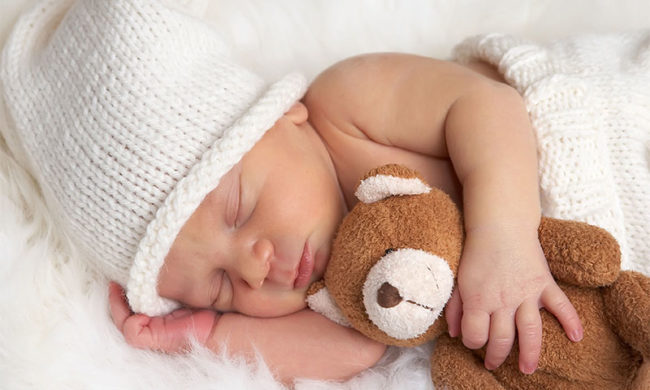
Mattress sizes for children
The size of the mattress must correspond to the size of the bed so that during sleep it does not slip, does not fall, does not hump. To avoid error during the purchase, it is advisable to measure the bed in advance with a roulette. You need to find out the width and length of the sleeping bed, as well as the height of the sides, if any.
For convenience, all cribs and mattresses are made in accordance with the dimensional grid. Therefore, parents do not have to worry and think which mattress for the child to choose so that he approaches the bed. So, for babies up to a year, mattresses are intended with a size of 60x120 or 70x140 cm. Next are more sizes - 80x190, 90x195, 80x200, 90x200 cm.
The degree of stiffness of the children's mattress
Special attention is paid to the rigidity of the mattress for the child. In childhood, the spine is very mobile and is quickly formed, so you need to stop attention on the "golden mean". The mattress should not be too soft or too hard, so it is better to choose orthopedic models with an optimal level of rigidity by age.
- For kids from birth to three years, the mattress can be chosen more hard, for example, from Koyra.
- A mattress for a child of 4-7 years old is needed by moderate stiffness, capable of maintaining a forming spine without excess load.
- After seven years, a medium rigidity mattress is allowed, which maintains the anatomical position of the body, without violating the level of comfort.

Children's mattresses - types, their advantages and disadvantages
A complex dilemma arises in front of parents, which mattress for a child: with a Bonnel block or independent springs, cotton or foam, latex or with a coyra. To make it easier to make a decision, consider the pros and cons of all types of mattresses.
Spring mattresses for the bed of a child
Spring mattresses are made on the basis of steel springs. They make mattresses orthopedically correct, which allows you to maintain the contours of the body: under heavy parts of the body, the springs bend, and under the lungs, support the desired shape. However, the child has less weight than in an adult, so the children's mattress should be less rigid and not too high.
The spring mattress may consist of dependent springs (Bonnel blocks), as well as independent springs. The latter increase the cost of the mattress and make it more camphor and reliable.
Children's mattresses with dependent spring blocks
Matras with Bonnel blocks appeared for a long time, and became the predecessors of modern unright models. The design of the mattress consists of many springs, which are interconnected in such a way that each spring curl pulls the following.
Blocks with continuous weaving consist of springs of different diameters, density and number of turns. The common models of Bonnel blocks consist of 90-100 springs per square meter. m, each of which is twisted in 3-5 curls with a diameter of 10 cm.
Important! The higher the density of the spring and the smaller diameter, the better the quality of the mattress: it is more elastic, durable and ergonomic. But even if the highest quality springs, the mattress with blocks of Bonnel can hardly be called orthopedic and, moreover, suitable for the child.
The advantages of this type of mattress:
- Excellent air and moisture permeability.
- Low cost.
- Strength and reliability.
There are much more disadvantages with dependent blocks:
- Minimum orthopedic properties.
- The relatively quick loss of elasticity and the appearance of jam.
- Noise, creak while moving springs.
- The shallowness of the surface and the appearance of "waves" at the time of the change of body position.
- A strong interconnection of springs creates the “hammak” effect and parts of the body are at different levels.
- If the foam coating is not dense enough, the springs are felt under the weight of the body and cause discomfort during sleep.
Such disadvantages of this spring mattress for the child make it unattractive from the point of view of orthopedics.
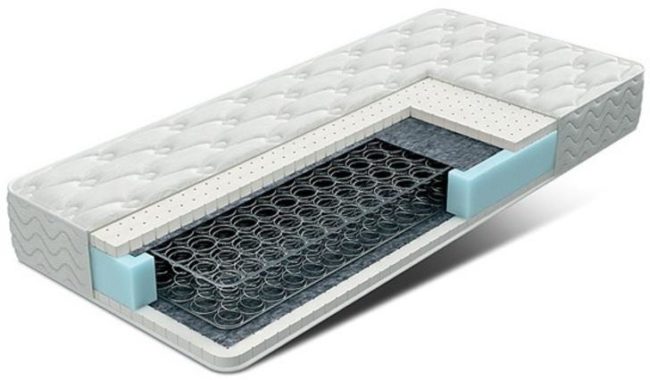
Mattresses for children with independent springs
The peculiarity of this type of mattress is the autonomous work of each spring, which is enclosed in a durable fabric bag. So, the spring bends and extends regardless of neighboring springs, which allows you to convey the shape of the body as accurately as possible. These are optimal orthopedic mattresses for children.
Advice! The larger the number of springs per square meter. m, the more expensive the mattress and the more he can withstand the load. But for childhood, you can limit yourself to buying a mattress with 250-300 springs per square meter. m. and their diameter 5 cm.
The pluses of the mattress:
- Uniform distribution of load on the mattress.
- The correct position of the child’s body during a night holiday.
- The stability of the surface of the mattress: no waves and fluctuations.
- Lack of noise.
- The average cost with good quality.
There are only two minuses of this mattress:
- The large weight of the mattress, which complicates the care of it.
- The mattress is very high, which is not suitable for all types of beds, especially with sides.
Given these insignificant disadvantages, we can confidently say that such mattresses are suitable for children from 5 years old.
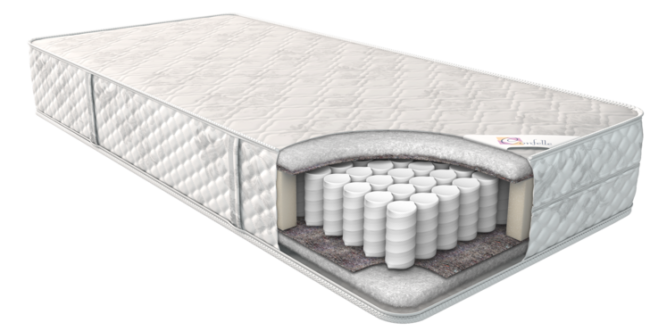
Non -free mattresses for children
The mattress without springs is a block of artificial or natural material, which can be monolithic or multi -layer. From the spring, this mattress is distinguished by the following properties:
- Non -nuclearity - the absence of springs excludes any creak.
- Mobility is the mattress light, compact, it is easy to care for it.
- Safety - there are no metal parts in it.
The species assortment of unright mattresses is very wide. Consider models with the most popular fillers that are designed for children.
Mattresses with polyurethane foam for children
Poliuretan foam (PPU) is a material resembling ordinary foam. This is a synthetic and cheap filler with a short service life. He does not possess good orthopedic properties, but in comparison with the same foam, more adapted for the children's spine. However, such a mattress is suitable for a child from 6 years old.
Advantages of mattresses with PPU:
- Low price.
- Lightness and elasticity.
- Convenience.
But the disadvantages of the mattress are more significant:
- Short life.
- A high degree of absorption of moisture without its return.
- Increased risk of using toxic materials.
Despite the promotion of manufacturers about the convenience and benefits of mattresses with PPUs, it is not recommended to buy them for the sleeping place of the child. Such a mattress is not able to fully support the body during sleep in the right position, it can cause allergies, does not provide breathability. Therefore, if you just think about which mattress is better for a child, do not even consider this option.

Cokosos Koyra mattress
Coconut Koyra is a plant filler of fibers covering coconuts. This material is very often used for the manufacture of children's mattresses, because it is completely natural and does not provoke allergic attacks.
Monoblock mattresses from Koyra are on sale, but they are too hard and uncomfortable. They are ideal for people with existing orthopedic problems, because their density can be compared with a sheet of chipboard. For children, Koyra can be used only in tandem with other, more elastic fillers. It is especially important to take this into account when choosing a mattress for a child in a year, when its weight increases rapidly, and it fully feels the hardness of Koyra.
Often Koyra is combined with artificial latex. Such a filler for children is unacceptable, since it may contain formaldehyde. This substance is highly toxic and can cause many diseases in a child. Therefore, during the purchase, you need to carefully study the composition of the filler.
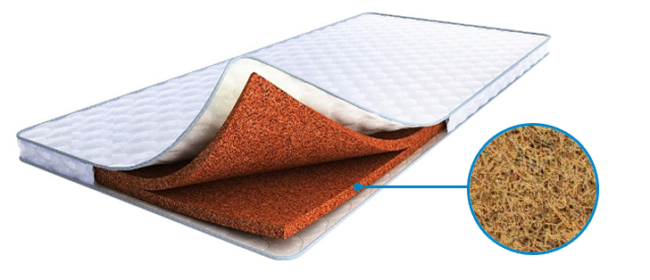
Mattress with natural latex
Latex - vegetable filler made of rubber -bearing milk. Synthetic analogues of latex can also be met on sale, but they are not intended for childhood.
In accordance with sanitary standards, the children's mattress should contain at least 40% of plant latex. Only in this case he will have such characteristics:
- Comfortable body position during sleep.
- Excellent orthopedic properties.
- Long service life.
- Good air and moisture volume properties.
- Environmental friendliness and hypoallergenicity.
This mattress has no disadvantages. Among the unright models, it is out of competition. The only negative is the high cost. If you have a low price bribed you, then you came across a cheap synthetic rubber. In this case, it is better to review your choice in favor of the mattress with independent springs.
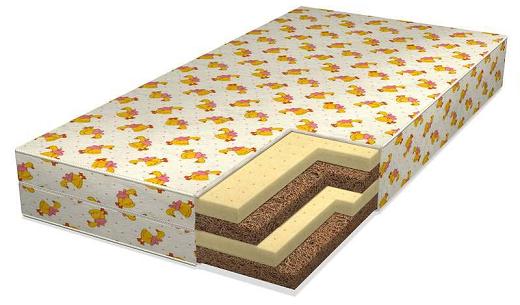
Mattresses with other fillers
Many mattresses with different fillers are on sale. I would like to pay special attention to materials such as cotton, camel wool, fluff, synthetic winterizer. For children, mattresses with such a filler are absolutely not suitable. Firstly, they are not orthopedic, secondly, they can cause allergies in a child, and, thirdly, do not provide moisture exchange.
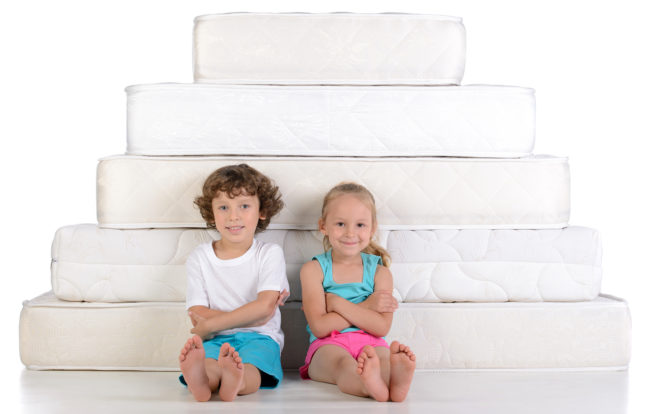
Which is better - a spring or unrevored mattress for a child?
A comparison of their basic parameters will help to make a choice in favor of a spring or unright mattress:
- Hygiene. Dust actively accumulates in spring blocks, and it is almost impossible to get it from there. Non -free models do not have such a shortage, especially if the Latex and Koyra filler. The exception is cotton and woolen mattresses that serve as a cozy house for dust mites.
- Static properties. In the spring blocks, due to a metal basis, there is static electricity. As a rule, this is not in the non -free mattresses, but if the mattress sheathing is made of synthetic fabric, the effect of electrification is still present.
- Care. The spring mattress is "afraid" of moisture. If it is strongly soaked, moisture will cause the corrosion of the springs, they will begin to creak and collapse, especially often this happens with the springs of the Bonnel. With unright mattresses, the situation is different: they are easy to clean, dry quickly. But this applies only to perforated models on a latex basis.
- The comfort of sleep. It is convenient to be located on the spring mattress, because it is soft and the body takes the right position, but due to reinforced edges, the effect of swinging is created, which is not very useful for the children's spine. On a non -agent mattress, you can easily be located over the entire area without swinging and slipping into the middle, but over time there may appear in places where the person is most often sleeping. In addition, if a mattress is made of coconut fiber, the child can be firm and inconvenient.
- The service life. The spring mattress will last about 10 years, latex 15, cotton or coconut will have to be changed every 3 years.
Advice! For children, the best choice will be a non -free latex mattress or mattress with an independent spring block. The remaining models are less complies with the adopted norms.
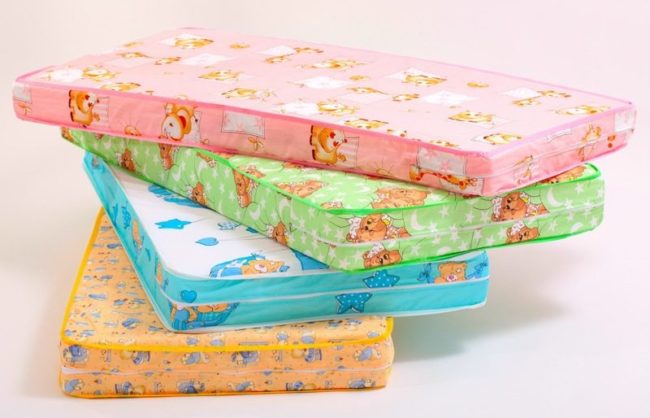
Choice of mattress in accordance with the age of the child
When choosing a mattress, you need to take into account not only the quality of the filler, stiffness and size, but also the age of the child. As it grows, the children's body needs different conditions for sleep and rest.
Choosing a mattress for a newborn child
For the smallest, you need to purchase hard mattresses that will not bend. If the child is 0-2 years old, which mattress should he choose? As a rule, these are mattresses made of coconut fiber with a layer of natural latex. The mattress under three years should be moderately thick so that he could not fall under the weight of the baby.
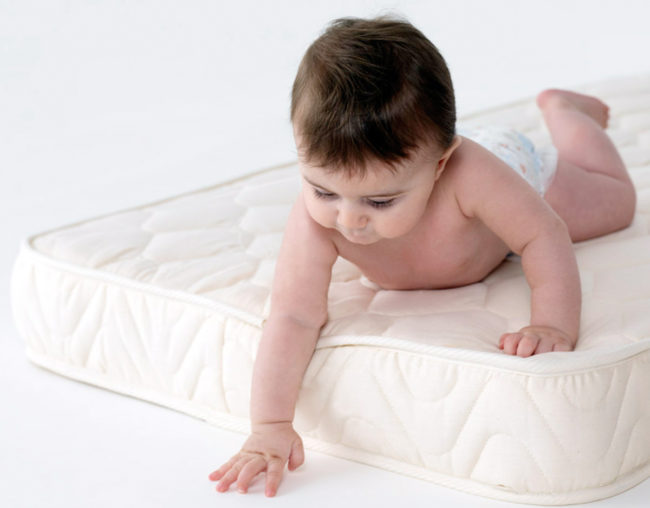
What are mattresses for children from 3 years old
In children over three years old, the spine takes the shape of the letter S, so too hard the mattress will create inconvenience. A great option for this age is a mattress with natural latex. Non -free mattresses for this age are not recommended, but, in extreme cases, you can purchase a mattress with independent medium density springs.

Which mattress for a 5-7-year-old child is better
After five years, the child moves from the crib to a more adult. The degree of stiffness of the new mattress is average. The filler can be from PPU, latex, combined (Koyra and latex). Spring mattresses are also suitable, with the exception of a bonnel. But the mattress should be exclusively single with a small number of springs per square meter. m.
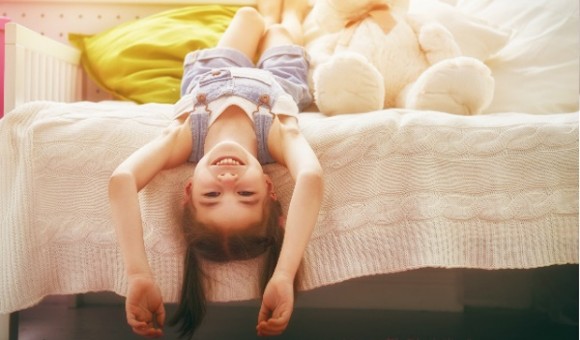
Which mattress for a child is 7 years old and older
At this age, the child is already a schoolboy. His spine experiences a tremendous load, so he needs a good rest. The desired conditions are created by independent spring blocks of medium stiffness. This mattress supports the bends of the vertebra in a relaxed state and does not violate their development. When choosing a mattress, a child is 10 years old and older, you can choose models with a large number of springs, since this requires the weight of the child's body.

The best mattresses for children
Among the most commonly purchased mattresses for children, several famous brands can be distinguished:
- Plitex - Indisputable leaders among children's mattresses. These are 2-sided and orthopedic models based on latex, coirs and synthetic winterizer.
- Ormatek - mattresses with independent springs from the Russian manufacturer. As an elastic layer, Koyra or latex is used.
- Mediflex - Non -free mattresses with orthopena. For stiffness, there is a ball of thermaced linen. For convenience, the mattress is dressed in a removable terry cover.
- Dreamline - A moderately hard and very strong mattress consisting of layers of Koyra and natural latex. The cover is made of a whip with a beautiful pattern.
- Fairy -Economy Variant from Hollofiber to a Czech from Byazi. The mattress is inexpensive, durable, breathable.
- Ascona - A semi -rigid mattress with a combined filler. Ascon mattresses for children are made from mini-blocks Bonnel, felt and PPU.
- Monis style - The budget option with Bonnel, Hollofiber and Koyra. Issued with a jacquard cover.

Mattress for children - reviews
Parents about children's mattresses are different. Some prefer natural mattresses from coconut fiber and buckwheat, others - premium spring mattresses. But, in any case, everyone is unanimous - it is not worth saving on the children's mattress.
Positive reviews about unrighted latex mattresses are leading. It is convenient for children to sleep on them, they fully meet hygiene requirements, moreover, they have an affordable cost. Particularly popular are 2-sided mattresses that can be turned over, which extends their service. Such a characteristic as “Winter-summer” is also important. Such mattresses have different fillers from two sides and are designed for different climatic conditions.
Negative reviews are found about cotton, foam and woolen mattresses. It is difficult to care for them, they quickly accumulate dust and often become the culprits of children's allergies.
There is no answer to the question of which mattress is better for the child. The choice depends on many factors, so before buying you need to evaluate your financial capabilities, the age of the baby and your preferences.









Comments
a couple of years ago, there was no side of metrogils from the same problem, there were no side effects ...
I’m not a fan of peeling at all, it saves from acne of metrogil, it also smoothes it ...
Great article! ...
I take the second course of the Capsules Climafite 911. The tides went very quickly. It became calmer, irritability went away and I sleep well ...
i also noticed - it is worth nervous, everything immediately affects the face. Therefore, I try to avoid conflicts and unpleasant people. Of the creams, I like Miaflow from wrinkles - smoothes not only small wrinkles ...